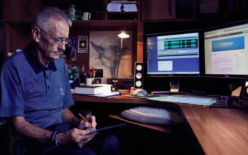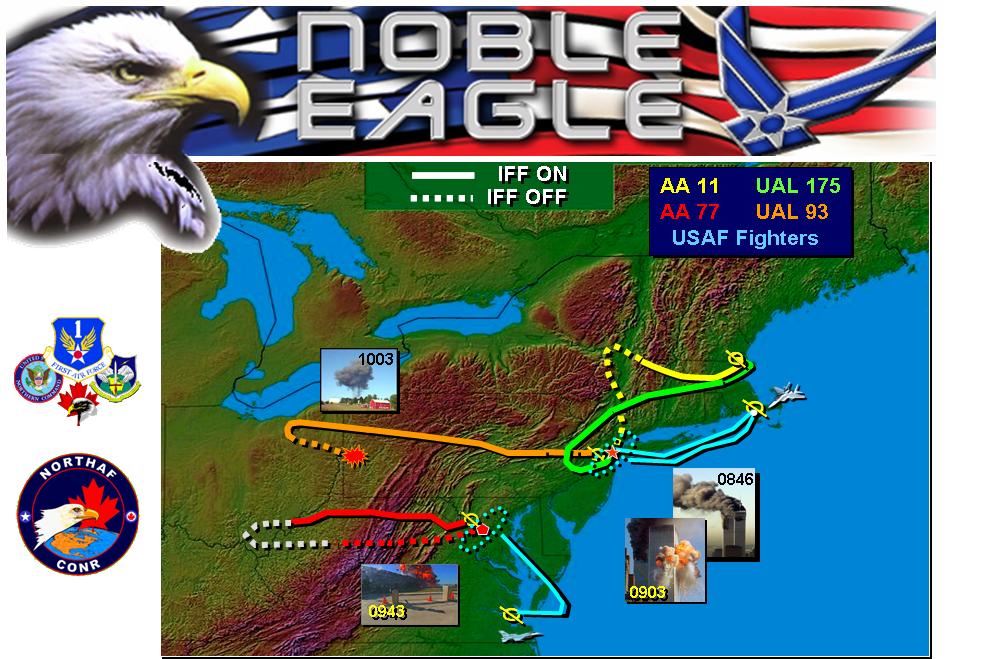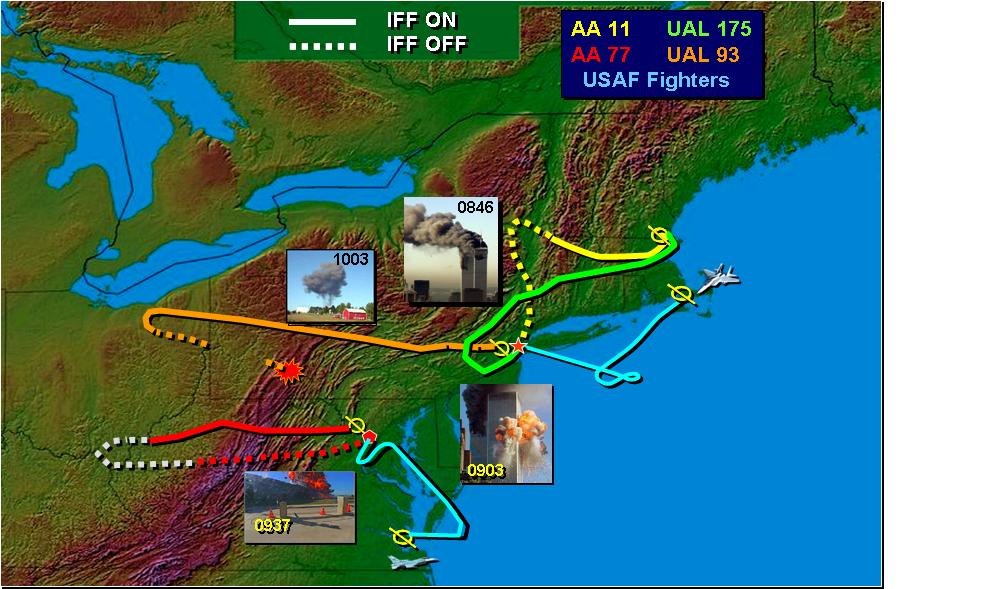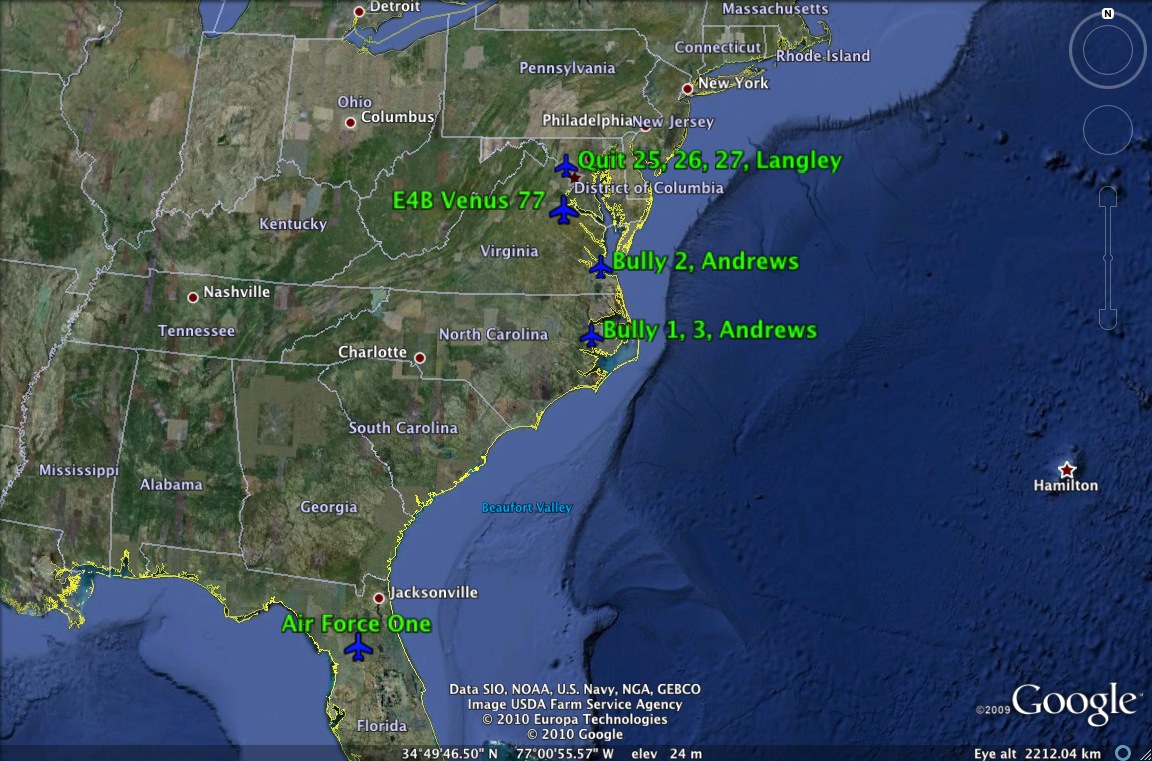Background
I am going through the primary source audio files from NEADS for the days prior to 9-11 specifically to assess Exercise Vigilant Guardian. In previous articles we found that there was, for now, one major event each day. We also established that the exercise hours were 1000-2200 each day until 24-hour operations were required.
On Sep 6, NEADS dealt with a wayward C-130 that required a scramble and escort to a base. On Sep 7, the main event was a defecting Russian aircraft that required NEADS to determine a diversion landing field, not JFK, and to scramble and escort the Aeroflot plane to the diversion field. Moreover, NEADS had to coordinate with the FBI for someone to meet the plane on arrival.
In this article we will discuss the events of Sep 8.
Real World
The audio files for Sep 8 reinforce that the NEADS/NORAD focus, as testified, was outward. All Cubana (Cuban) and Aeroflot (Russian) aircraft were special tracked; the flight plans were provided by either FAA or its Canadian counterpart. In this audio clip NEADS is heard designating an Aeroflot flight as a “Special 20.” 0908163030 Aeroflot Special 20
In this next clip a couple hours later we hear NEADS and Oak Grove (SEADS) discussing and monitoring a Cubana flight. 0908190544 Cubana and Oak Grove
NEADS then passed the information, with specificity to the Surveillance section and the track is identified as a Special 23, “anything going to and from Cuba. 0908190717 NEADS Cubana discussion
Unknown tracks of potential interest were all over water. Most faded away or turned out to be bad data. In this nearly five minute clip the NEADS staff is heard going through their procedures, to include a live world scramble order. Towards the end of the clip a caller asked about an exercise issue. The caller was told, “we’ll call you back.” This is an example of how NEADS balanced real world and exercise issues, in perspective. 0908193213 Real World Takes Precedence
NEADS Identification Technicians checked with concerned FAA centers and with Giant Killer since the unknown track was in offshore training area Whiskey 105. Ultimately, NEADS determined the track to be a possible ship and did not scramble. This next audio clip is part of the mandatory unknown report to CONR. 0908193825 Unknown report to CONR
And in this interesting exchange between NEADS and the Otis Command Post we learn that in the process of scrambling and then standing down only one of the two Otis alert fighters was actually started. We also gain more insight into how degraded the air defense mission was as of 2001. Otis had no Supervisor of Flying (SOF) on duty on weekends and if refueling was required on the ground additional people had to be recalled. 0908194349 Exchange with Otis Command Post
We also learn that the NEADS floor provided morning as well as evening briefings to key personnel at headquarters. (The headquarters building was separate from the NEADS sector operations center.) The following two clips contain the morning briefings for the Commander, Colonel Marr, and the Director of Operations.
0908104934 Col Marr Morning Brief
0908112617 DO Morning Brief
Exercise
NEADS exercised tracking certain U.S. aircraft. One such scenario had NEADS assisting an EP3 land at Brunswick, Maine. For the exercise, a special track was created for “Air Force Two” returning to Andrews AFB from Helsinki. Here is the audio file. 0908165109 Air Force Two Special Track
Recall that there was a major Russian exercise ongoing and NEADS was watching that as well. Specifically, Russian strategic bombers, codenamed “Bear” were flying. A flight of Bears was near Canadian airspace and there was some discussion on what to do with American fighters. The decision was made to keep the fighters in American airspace. In this next clip we hear one side of a conversation between the Mission Crew Commander and probably the Battle Cab as he explained the rationale for his action. Historically, the bread and butter of the Continental United States air defense mission was intercepting and escorting Soviet strategic bombers, especially when they were forward deployed to Cuba. NEADS knew “Bears;’ they knew what to do. 0908185648 Russian Bears Flying
At a shift change the US reaction to the Russian exercise was discussed. In this clip we hear that Alaska and CANR (Canada) were reacting, that fighters were forward deployed to King Salmon and Galena, and that CINCNORAD and JCS were involved and concerned. 0908190702 Shift brief on reaction to Russian exercise
The Main Event
The NEADS task on Sep 8 was to deal with a probable drug trafficker out of Bermuda with a scheduled flight plan. The problem was that the track split into two tracks, meaning that a second plane took off in trail of the first aircraft in an attempted deception. NEADS had to figure that out and then obtain guidance on what to do. The guidance was to “radar flight follow” both tracks; there was no scramble.
In the aftermath, in background on many of the audio files, the NEADS staff can be heard discussing the what-ifs of a split track and how to deal with that.
The scenario began with the NEADS ID section announcing and seeking information from the simulation cell about unknown track B673, a possible Customs squawker. 0908204005 Track B673. The time was 2102Z.
That announcement was immediately followed by the decision to make an “unknown riders” call, a broadcast message asking the unknown to respond. Note that the decision to make this a five-minute track was also discussed. That meant the ID section had that amount of time to identify the track. 0908204059 Unknown Riders Call
NEADS issued a scramble order for Atlantic City on track B672 [sic] and then pushed the simulation cell for additional information. The cell was initially uncertain as to whether the track was friendly or not but quickly asked for all the help they could get on a drug carrying aircraft out of Bermuda. 0908204242 Scramble on Bermuda Drug Smuggler
NEADS then received an additional sim call from FAA’s New York Center advising that they were talking to the aircraft, tail number N527MB, and that it would be assigned a new code, 3714. 0908204336 Tail Number N527MB ZNY
That caused an discussion on the floor about “going friendly.” The ID technician pushed for the designation and she was successful. The track was designated friendly at 2108Z. In the midst of that discussion a new track, B010, real world, popped up. This next clip is a good example of how NEADS treated the two, concurrently. Track B010 was later dropped as bad data. 0908204510 Designated Friendly
Anytime NEADS established a track and forward told (linked electronically) it to CONR a report was required. In this next clip we hear the beginning of that report concerning B673. The rest of the report was pro forma, simply a pass of information that was known by block number on a form. Of interest is that CONR briefly conflated the exercise event with a real world event, track R335 from WADS. 0908204551 Report to CONR
As the R335 track discussion continued NORAD, who was also on the call, explicitly told CONR to work that issue because “real world is a little more important than exercise.” 0908205214 Real World More Important
In this next clip we hear the pro forma second part of the initial report to CONR and NORAD on track B673. I include it to show the specificity of information and the sharing of that information at all NORAD echelons. The NORAD participant is the Air Warning Center (AWC). 0908205652 B673 Complete Report to CONR and NORAD (AWC)
On the NEADS floor the discussion about designating N527MB a friendly continued. The Atlantic City fighters were kept on the ground and the decision was made to “radar flight follow.” 0908204724 Radar Flight Follow
However, the floor discussion continued and the final NEADS decision, for the moment, was to reclassify the track a Special 17 (unknown), because of the decision to “radar flight follow.” That decision was announced to the floor at 2111Z. 0908205017 Reclassified Special 17
At this point in the scenario we have covered about 10 minutes of real time, with floor conversations available on multiple channels on the NEADS floor. NEADS has dealt with a probable drug-related unknown but does not yet have a clear operational picture. Fighters were scrambled but not launched. Working with simulated FAA, NEADS decided to leave the fighters on the ground.
The Track Splits
The first apparent indication of a track split comes from the ID technicians who are discussing the pace of the evening’s activity. During that discussion they pick up a new unknown, B045. That track would have been established by the surveillance technicians. Here is that first indication. 0908205639 Track B045
The ID technician soon realized it was a split track and informed the MCC. They discussed what to do and the ID technician announced the track as a Special 17 (Unknown) at 2119Z. 0908205730 B045 Special 17
The split was also reported to CONR. This exchange clearly shows that CONR could only see tracks that had been forward told by NEADS or one of the other sectors. 0908210028 Split Reported to CONR
The MCC talked to, most likely, the Coast Guard in the Sim Cell and it was determined that NEADS would provide 10-minute updates on both tracks and landing information on the one that FAA was talking to. 0908210030 MCC Discussion with Sim Cell
The ID technician called FAA’s simulated Washington Center about the split. That surfaced an interesting exchange involving the controllers. The issue was why did NEADS make the track a Special 17. 0908210405 Sim Cell Floor Discussions
As with the earlier track the split, B045, was reported to CONR and NORAD. In this clip it is specified that the CONR position is in the RAOC (Region Air Operations Center). The RAOC link is to the 1996 NORAD Instruction 10-31 concerning the ADNET (Anti-drug Net). 0908210456 Track B045 Report to CONR
In the Aftermath
Several minutes later the NEADS floor was trying to figure out what happened. They discussed the possibility of three tracks, B673, B045 and code 3714. In this next clip we hear that they decided there were two tracks. We also have an explicit example of how the MCC could “camp on” (listen in) to any position on the floor, in this instance the ID position. 0908210900 NEADS Floor Discussion
In this next clip the MCC defends his decision to make the second track a Special 17 and learns it should have been a “pending” track. 0908211151 Should Have Been Pending
Nevertheless, the MCC continues to defend his position and we learn at the end of this next clip that he is actually defending his position not to scramble fighters. The ID Technician attempts to take the blame for the miscue, but ultimately it is the MCC’s decision. 0908211223 Decision Not to Launch
The discussion continued on into the evening. In this clip the MCC explains that they, NEADS, aren’t going to do anything except provide a landing base. Having a fighter behind the smuggler won’t do anything. 0908211612 F16 won’t do anything
He continues to explain that maybe “up there” (Battle Cab) might have scrambled if the second track had been a pending unknown as opposed to a Special 17. 0908211721 Might Have Scrambled
My Assessment
NEADS should have scrambled as was determined in the after action review. Although the ID Technician took responsibility for the failure to scramble the responsibility was ultimately that of the MCC.
It is not surprising that Exercise Vigilant Guardian would have at least one counter-drug scenario. After the end of the cold war Congress made money available for a major national counter-drug program. NORAD was quick to carve out a mission for itself especially since its primary mission, guarding against the Soviet threat had dissipated. The new NORAD mission is reflected in the NORAD Instruction concerning the ADNET, as linked above.
Importance Concerning 9-11
What we have heard is that NEADS had specific procedures in place to handle unknown tracks as they occurred. However, NEADS actions, including the forward tell of tracks of interest to CONR and to NORAD depended on a track being established. A designated track was the key to everything that followed.
Understanding that NEADS (and WADS and SEADS) worked from a designated track paradigm is key to understanding what happened in the air defense response during the terrorist attack on the morning of 9-11. There was never a designated track on any of the hijacked aircraft, except briefly on AA 77 (B032), a track that immediately faded. Therefore, no operational information was ever forward told to CONR or NORAD.
The only track that was established and followed procedurally was B089 (Delta 1989). It is only that track that NORAD reported to the NMCC-convened Air Threat Conference. It is only that track that General Arnold and Colonel Marr saw “meander” that morning. It was not UA 93.
Exercise Hours
We learn that NEADS sector personnel anticipated the shift to 24-hour operations to occur on Wednesday [Sep 12], that is when their duty shifts would change to 12 hours. Here is the floor discussion; there is some uncertainty. 0908210646 12-hour Shift Discussion
If accurate, this is an important point. It means that on the morning of Sep 11, the exercise was not scheduled to start until 1000 hours. Thus, the exercise was not a factor during the time that AA 11, UA 175, and AA 77 were an issue.
Updated Nov 30, 2010. I have added a preamble to the article for Sep 6 which indicates that 24-hour operations were scheduled to begin on Sep 10, 2010
We will learn more as I listen to the audio tapes for September 9 and 10, 2011.



